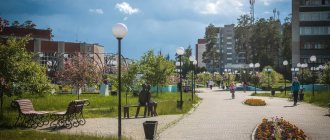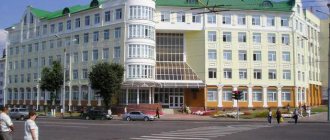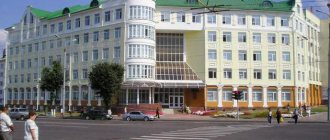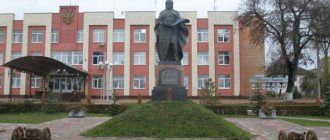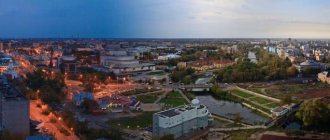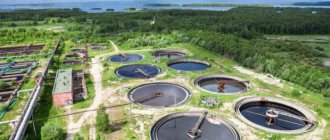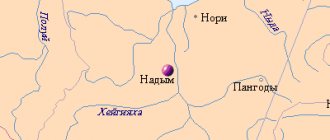The Sverdlovsk region is a subject of the Russian Federation, part of the Ural Federal District, bordering the Perm Territory, the Komi Republic and the Khanty-Mansi Autonomous District, the Tyumen, Kurgan, Chelyabinsk regions and Bashkiria. On an area of 194,307 square kilometers (17th largest among the constituent entities of the Russian Federation) occupied by the region, there are 47 cities and 26 urban-type settlements.
Cities of the Sverdlovsk region: Alapaevsk, Aramil, Artyomovsky, Asbest, Berezovsky, Bogdanovich, Verkhny Tagil, Verkhnyaya Pyshma, Verkhnyaya Salda, Verkhnyaya Tura, Verkhoturye, Volchansk, Degtyarsk, Yekaterinburg, Zarechny, Ivdel, Irbit, Kamensk-Uralsky, Kamyshlov, Karpinsk, Kachkanar, Kirovgrad, Krasnoturinsk, Krasnouralsk, Krasnoufimsk, Kushva, Lesnoy, Mikhailovsk, Nevyansk, Nizhny Sergi, Nizhny Tagil, Nizhnyaya Salda, Nizhnyaya Tura, Novaya Lyalya, Novouralsk, Pervouralsk, Polevskoy, Revda, Rezh, Severouralsk, Serov, Sredneuralsk, Sukhoi Log, Sysert, Tavda, Talitsa, Turinsk.
For ease of use, we provide a detailed list in the table below:
| City | Based | Square | Population |
| Ekaterinburg | 1723 | 468 km² | 1 495 066 |
| Alapaevsk | 1639 | 95 km² | 36 951 |
| Aramil | 1675 | 21.8 km² | 15 791 |
| Artyomovsky | 1665 | 47 km² | 29 754 |
| Asbestos | 1889 | 74.5 km² | 62 285 |
| Berezovsky | 1748 | 74 km² | 60 334 |
| Bogdanovich | 1885 | 23 km² | 29 309 |
| Verkhniy Tagil | 1716 | 31.3 km² | 10 428 |
| Upper Pyshma | 1854 | 60 km² | 74 262 |
| Verkhnyaya Salda | 1778 | 72 km² | 41 026 |
| Verkhnyaya Tura | 1737 | 15 km² | 8862 |
| Verkhoturye | 1598 | 9 km² | 8525 |
| Volchansk | 1900 | 63 km² | 8458 |
| Degtyarsk | 1914 | 19 km² | 15 326 |
| Zarechny | 1955 | 27.6 km² | 28 171 |
| Ivdel | 1831 | 50 km² | 15 244 |
| Irbit | 1631 | 64.2 km² | 36 128 |
| Kamensk-Uralsky | 1701 | 144 km² | 163 990 |
| Kamyshlov | 1668 | 52 km² | 25 582 |
| Karpinsk | 1759 | 83 km² | 25 599 |
| Kachkanar | 1957 | 317 km² | 37 687 |
| Kirovgrad | 1661 | 10 km² | 18 577 |
| Krasnoturinsk | 1758 | 71, 9 km² | 55 910 |
| Krasnouralsk | 1925 | 21.7 km² | 22 304 |
| Krasnoufimsk | 1736 | 127 km² | 37 444 |
| Kushva | 1735 | 50 km² | 26 787 |
| Forest | 1947 | 360 km² | 49 259 |
| Mikhailovsk | 1805 | 21 km² | 8720 |
| Nevyansk | 1701 | 17 km² | 22 900 |
| Nizhniye Sergi | 1743 | 19.9 km² | 8891 |
| Nizhny Tagil | 1722 | 298.5 km² | 344 656 |
| Nizhnyaya Salda | 1760 | 590, km² | 17 229 |
| Nizhnyaya Tura | 1754 | 1939 km² | 19 091 |
| New Lyalya | 1903 | 20 km² | 11 596 |
| Novouralsk | 1941 | 31.9 km² | 79 638 |
| Pervouralsk | 1732 | 66 km² | 119 365 |
| Polevskoy | 1718 | 57 km² | 60 012 |
| Revda | 1734 | 111 km² | 60 761 |
| Dir | 1773 | 33 km² | 36 420 |
| Severouralsk | 1758 | 35 km² | 25 157 |
| Serov | 1893 | 94 km² | 95 141 |
| Sredneuralsk | 1931 | 83.8 km² | 23 889 |
| Sukhoi Log | 1710 | 1684 km² | 33 048 |
| Sysert | 1732 | 20 km² | 21 029 |
| Tavda | 1910 | 148 km² | 32 338 |
| Talitsa | 1732 | 64 km² | 15 486 |
| Turinsk | 1600 | 28 km² | 16 999 |
The secret of the origin of the name
Historians suggest that the name of the city - Aramil - comes from the Turkic language. There are several variations of its translations:
• “aram”, which means “sadness”;
• “il”, meaning “homeland”;
• “areme” – translated as “a place overgrown with small bushes by the river.”
They also tell a sad legend about a missing beauty. It says that for a long time the grieving father unsuccessfully called for his missing daughter Aramil, but she never returned. The girl, according to different interpretations of the legend, could have drowned, been kidnapped, or gotten lost in the thicket of the forest. And the search place was named after her.
Local residents believe that their city is called by a woman's name. And they say “in Aramili.” It is this unique feature that sets it apart from the rest, because you can find few populated places whose names are feminine. The rest of the town's guests say "in Aramil." Official circles also tend to favor a masculine interpretation of the name.
Excerpt characterizing Aramil (village)
“Who didn’t tell them to catch me twenty times?” But they will catch me and you, with your chivalry, anyway. – He paused. - However, we have to do something. Send my Cossack with a pack! I have two French uniforms. Well, are you coming with me? – he asked Petya. - I? Yes, yes, absolutely,” Petya cried, blushing almost to tears, looking at Denisov. Again, while Dolokhov was arguing with Denisov about what should be done with the prisoners, Petya felt awkward and hasty; but again I did not have time to fully understand what they were talking about. “If big, famous people think so, then it must be so, therefore it’s good,” he thought. “And most importantly, Denisov must not dare to think that I will obey him, that he can command me.” I will definitely go with Dolokhov to the French camp. He can do it and so can I.” To all of Denisov’s urgings not to travel, Petya replied that he, too, was used to doing everything carefully, and not Lazar’s at random, and that he never thought about danger to himself. “Because,” you yourself must agree, “if you don’t know correctly how many there are, the lives of maybe hundreds depend on it, but here we are alone, and then I really want this, and I will definitely, definitely go, you won’t stop me.” “, he said, “it will only get worse... Dressed in French greatcoats and shakos, Petya and Dolokhov drove to the clearing from which Denisov looked at the camp, and, leaving the forest in complete darkness, descended into the ravine. Having driven down, Dolokhov ordered the Cossacks accompanying him to wait here and rode at a fast trot along the road to the bridge. Petya, transfixed with excitement, rode next to him. “If we get caught, I won’t give up alive, I have a gun,” Petya whispered. “Don’t speak Russian,” Dolokhov said in a quick whisper, and at that same moment a cry was heard in the darkness: “Qui vive?” [Who's coming?] and the ringing of a gun. Blood rushed to Petya's face, and he grabbed the pistol. “Lanciers du sixieme, [Lancers of the sixth regiment.],” said Dolokhov, without shortening or increasing the horse’s stride. The black figure of a sentry stood on the bridge. – Mot d'ordre? [Feedback?] – Dolokhov held his horse and rode at a walk. – Dites donc, le colonel Gerard est ici? [Tell me, is Colonel Gerard here?] - he said. – Mot d'ordre! - Without answering, the sentry said, blocking the road. “Quand un officier fait sa ronde, les sentinelles ne demandent pas le mot d'ordre...” Dolokhov shouted, suddenly flushing, running his horse into the sentry. – Je vous demande si le colonel est ici? [When the officer goes around the chain, the sentries do not ask for feedback... I ask, is the colonel here?]
Geography
The city of Aramil is located in the Sverdlovsk region, it is the center of the Aramil city administrative district. Its geographical coordinates: 56.6945 s. w., 60.8883 w. etc., refers to the UTC+5 time zone.
The city boasts the presence of the Aramil railway station (direction Ekaterinburg - Kurgan), which is located five kilometers outside the city. And in the north-west you can see the outlines of the Aramil airfield with the name “Uktus Airport”. If you drive 26 km southeast, you can get to Yekaterinburg.
This small cozy town has taken a fancy to the picturesque Ural mountain slopes on the eastern side of the ridge. The villages of Patrushi and Bolshoi Istok are located near the city borders.
The oldest cities in the Sverdlovsk region
The first cities on the territory of the modern Sverdlovsk region appeared at the turn of the 16th-17th centuries, long before Yekaterinburg. But it was inhabited long before the names of today's cities appeared. Numerous sites of ancient man have been found here, the appearance of which is dated from the Paleolithic to the Iron Age.
Verkhoturye, 1598. Founded in 1598 by the expedition of Vasily Golovin and Ivan Voeikov as a permanent protected point, which later became the main fortress on the way to Siberia. Verkhoturye is today both the oldest and one of the smallest cities in the Sverdlovsk region.
Turinsk, 1600. The settlement appeared on January 30 (February 9), 1600 as a fort on the site of the ancient settlement of Epanchin (Epanchin-Yurt) destroyed by Ermak. Its appearance is associated with the Babinovskaya road, built in 1597 from Solikamsk to the upper reaches of the Tura. A protected settlement between Verkhoturye and Tyumen served to guard the waterway to Siberia.
Irbit, 1631. The oldest settlements in these places date back to the second millennium BC (Bronze Age); modern Irbit is located almost on the site of the Irbit settlement, located on a hill near the northwestern outskirts of the city. It is believed that the ancestors of the Mansi lived here until the 13th century. In 1631, at the confluence of the Irbit River and Nitsa, a fort was founded.
Population
Residents in the city of Aramil are usually called this way: Aramilian (male), Aramilian (female), Aramilian (general).
The population density is 694.87 people/km2.
The population of Aramil is shown in the table below. Population
| Year | Thousand people | Year | Thousand people | Year | Thousand people |
| 1959 | 11 472 | 1989 | 13 584 | 2010 | 14 224 |
| 1967 | 15 000 | 1998 | 14 100 | 2013 | 14 544 |
| 1970 | 12 993 | 2002 | 15 076 | 2015 | 14 781 |
| 1979 | 13 382 | 2007 | 14 800 | 2017 | 15 162 |
The dynamics of changes in the population of the city of Aramil over 58 years (from 1959 to 2022) can be studied according to the graph.
Cities in the region with the largest population
Ekaterinburg, 1,495,066. The regional center is included in the group of 15 millionaire cities, the largest city in the region and the region, the regional center. Since 2005, the population of Yekaterinburg has been continuously growing, approaching 1.5 million. The fourth city among the largest in Russia.
Nizhny Tagil, 344,656. Second city by population in the region, industrial center. According to the All-Union Population Census, the record number of inhabitants was set in 1989, when 439,521 people lived in Nizhny Tagil. Since 2004, the city's population has been gradually declining, with a slight increase recorded only in 2011.
Kamensk-Uralsky, 163,990. Industrial city, large transport hub, third largest in the region by population. In 1991, the number of residents exceeded 200 thousand, but since then it has decreased every year, with rare exceptions.
The population of the remaining cities, except Pervouralsk, does not reach 100,000 inhabitants; the most sparsely populated urban municipalities are Verkhoturye and Volchansk, 8525 and 8458 thousand inhabitants, respectively.
City `s history
The city of Aramil in the Sverdlovsk region is one of the Ural long-livers. In the summer of 1674, the southern fortification post of the Russian state was erected on the border with Bashkiria - Aramilskaya Sloboda. By 1707, it included more than twenty settlements. It was here that factories were built that laid the foundation for the formation of such cities as Kamensk-Uralsky, Berezovsky, Yekaterinburg, Sysert and others.
During the civil revolution, the city was captured by the White Guards. Industry fell into decline. When the Soviets came to power, the city's revival began. The first factory was opened on the basis of a cloth factory. The students were Aramil children and children from orphanages. Also in the 30s, the first secondary school and an institution for training pilots were built.
17 collective farms were organized in Aramili. Gradually the city became the largest agricultural center.
During the Second World War, many industrial productions and enterprises were evacuated to the city, because there was no front line here.
In 1956, the merger of the Aramilsky and Sysert districts took place. Based on the results of the 1966 referendum, it was decided to secede from Sysert. In 1966, on September 15, Aramil received the title of city.
The city in modern conditions is a small settlement located near Yekaterinburg. New buildings are gradually being built in Aramil. Most of the town is not equipped with gas, but this problem is being solved.
A significant problem in the area is the Aramil pond. Since the late 60s, they have been trying to clear it of debris and silt, but this has never been done. It turned out that most of the garbage comes from the Iset River. Therefore, swimming in the pond is not permitted.
The placement of branches of the largest enterprises on the territory of Aramil and the development of local industry are prospects for the city.
History of Aramili
This settlement arose in 1675 from the Aramilskaya Sloboda - almost half a century earlier than Yekaterinburg. The founder is also known - Mikhailo Sarapulets. The Aramilskaya settlement appeared near the confluence of the Aramilka River and the Iset River. It was located on the site where the temple now stands.
In the 17th-18th centuries, the Bashkirs attacked the Aramil settlement more than once. To protect the settlement, it became increasingly stronger. A fort arose here, which was a wooden fortress with towers.
The writer Pavel Bazhov wrote about Aramil of that time: “In a small ring of fields, tightly sandwiched by coniferous forests, the Aramil settlement was alerted by two chopped forts. And in the forests along the road, people running away from different gentlemen are buried, whose thoughts are secretly to go to the free Siberian lands. The archers live in the prison and the governor sits there to keep an eye on it, so that there is no vacillation, theft and destruction of the treasury, and that yasak (tribute) is taken according to people and industries as much as possible...”
The Aramil settlement included a huge territory. The Uktus, Elizavetinsky, Verkh-Isetsky, Ekaterinburg, and Sysert plants were founded on its lands. The development of Ural lands and the construction of factories began from the Aramil settlement. Local residents, the Babin brothers, discovered many ore deposits in the Middle Urals in the first half of the 18th century. They also discovered the “Chud” mines on the site of modern Polevskoye - the Gumeshevskoye copper deposit.
After the appearance of the state-owned Uktus plant, the residents of Aramili were assigned to it, obliging them to participate in the factory work.
Several mills operated in Aramili and the surrounding area. One of them was owned by Mikhail Klementievich Ushkov, the eldest son of the builder of the famous Ushkovskaya ditch, for which the family received their freedom. Mikhail Ushkov first established cloth production in Aramili.
However, one of Ushkov’s heirs lost a large sum, and the factory was sold. The enterprise was bought by Rozhnev, who five years later (in 1895) sold the factory to the Zlokazov brothers. Under their management, the enterprise began to develop rapidly and went down in history as the Zlokazovskaya Cloth Factory. On the banks of the Iset, new red brick buildings grew up, surviving to this day.
During the civil war, Zlokazov left Aramil forever. A Zlokazovsky carved wooden sideboard from the end of the 19th century has survived to this day. It can be seen in the city local history museum.
The Aramil cloth factory became famous for its production of overcoats. During the Great Patriotic War, every fourth soldier wore greatcoats produced in Aramil!
In the 1930s, the Osoaviakhim pilot school was created in Aramili. A vast area near the village of Patrushi was allocated for the airfield. Eleven former flying club cadets became heroes of the Soviet Union during the war. And Grigory Andreevich Rechkalov, a former electrician at the Aramil mill No. 4, ended the war twice as a hero, having shot down 61 fascist planes on an American plane. In the village of Zaykovo near Irbit, a Rechkalov museum was created.
Now the Uktus airfield is actually not working. In past years, on Yekaterinburg City Day, air shows were held there. The authorities plan to open the second stage of the “Titanium Valley” on its territory (the first stage is located near Verkhnyaya Salda).
The Aramil aircraft repair plant operates nearby. On weekdays you can go on excursions here.
And one more significant episode in the history of Aramili. The Ilya Muromets plane landed here, making the first civil air flight on the Sarapul-Sverdlovsk route. They want to immortalize the landing site with a monument soon.
But there is also a sad page in the history of aviation. On the outskirts of Aramili, pilot Grigory Bakhchivandzhi crashed while testing a new jet aircraft on March 27, 1943.
The Sverdlovsk film studio filmed scenes from the films “In the Power of Gold” and “Privalov’s Millions” in Aramil. And in the 19th century, the author of these works, the writer D.N., also visited here. Mamin-Sibiryak, who came to visit his brother. In May 1926, writers P.P. came to Aramil to meet with readers. Bazhov and Demyan Bedny.
In 1966, Aramil received city status. Currently, the city's population is gradually growing and amounts to about 15 thousand people. Many new houses are being built. In the future, Aramil will probably become part of the city limits of the Ural capital. The villages of Patrushi, Bolshoi Istok and Borodulino are adjacent to Aramili.
Modern Aramil
In 2002, by decision of the Aramil Municipal Duma, the coat of arms of the city of Aramil was approved. It is numbered 1020 in the State Heraldic Register.
Today there are already 104 streets in the city of Aramil. The longest of them in the left bank part of the town is Rabochaya Street.
In 2009, houses began to be actively built in the city. Mostly three-story buildings were erected on Krasnoarmeyskaya, Rabochaya and Tekstilshchikov streets. Along the streets of 1 May and Cosmonauts you can see nine-story buildings. All new buildings in Aramil are economical housing that meets all the requirements for comfortable living.
The city's infrastructure has been formed. Development centers, shopping centers, swimming pools, and kindergartens continue to be built, thereby creating new jobs.
Developers are actively buying up nearby land. Aramil's location relative to Yekaterinburg provides development prospects.
Economy of Aramil
The satellite city of Yekaterinburg hosts many different industries on its territory. Increased migration distinguishes Aramil from other cities. More than two thousand visitors found work at his enterprises.
The basis of urban production is light industry. More than seventy percent of industrial workers are employed in this area. The cloth factory still remains the main production in the city. Its equipment is constantly updated and its staff consists of more than one and a half thousand people.
There are small local companies in the city of Aramil. This is a small food processing plant, the Sysert regional industrial plant, a plant for the production of electrical products and the 2nd branch of the Zvezda association. The city also produces products from a dairy and bakery plant, a mill plant and repair shops of the regional association “Selkhoztekhnika”.
Three secondary schools have been built in Aramil. There is also a city vocational school.
Among the cultural values, residents have the opportunity to visit the Zarya cinema, local clubs, the built House of Culture and the hospital campus.
Since October 2011, a plastic packaging production plant, Uralplastik-N, has been opened in Aramil.
Notes
- ↑ 1 2
Number and distribution of the population of the Sverdlovsk region (Russian) (inaccessible link).
All-Russian Population Census 2010
. Department of the Federal State Statistics Service for the Sverdlovsk Region and Kurgan Region. Access date: April 16, 2022. Archived September 28, 2013. - Aramilsky urban district\\Department of Information Policy of the Governor of the Sverdlovsk Region
- Rundqvist N., Zadorina O.
Sverdlovsk region. From A to Z: Illustrated encyclopedia of local history. - Ekaterinburg: Kvist, 2009. - P. 456. - ISBN 978-5-85383-392-0. - Directory of postal codes / OKATO codes / tax inspectorates of the Federal Tax Service / addresses. Aramil (village) (undefined)
(inaccessible link). Access date: October 13, 2015. Archived March 4, 2016. - Koryakov Yu. B.
Ethno-linguistic composition of settlements in Russia: [arch. November 17, 2020]: database. — 2016.
Industry of the city
Over time, the military significance of the fort was lost. Industry grew, and the settlement turned into a workers' settlement. Residents left military service and began developing land. Along with other settlements, Aramil became the base for the development of heavy industry in the Urals.
The Uktus plant was built a few kilometers from the settlement. The discovery of large deposits of copper ore marked the beginning of the construction of the Polevsky plant, and then several more valuable ore deposits were found.
In 1840 a blacksmith shop was built. It produced household items, and in 1857 the production of woolen cloth appeared.
The Civil War led the Aramil cloth factory to decline. There was no work in Aramil, and those who worked were not paid. They were mainly engaged in farming. But by 1923, the factory was restored, and its production level increased compared to pre-revolutionary levels. The production of coarse cloth for overcoats was established, and later - patterned fabrics. In addition to cloth production, workshops, a brick factory and a flour mill were built in the town.
In 1941, the Kiev plant was evacuated to the city of Aramil, Sverdlovsk region. It was assigned the number 508. The plant was engaged in the production of gunpowder. In the post-war years, the company began to produce artificial fibers. In the 70s, the factory was reorganized and became known as “Polymercontainer”. Now it was decided to establish plastic production.
Today, two mills have been preserved in Aramil, they have been improved and are in working order. Modern mill No. 3 is one of them. And mill No. 4 is the second.
At the end of the 90s, a caravan plant was put into operation and at the same time a stone processing factory (“Mramorgaz”) was put into operation.
Aramil
| The small provincial town of Aramil (in many ways externally reminiscent of a village) is located only 15 km south of Yekaterinburg and in the future has every chance of merging with the Ural metropolis. Nevertheless, there are quite a few interesting moments in his past and present, most of which I will try to talk about in this article. |
Coordinates for GPS navigator
56.691906236237536, 60.86251799999991
Aramil city on the map
Thanks to archival documents that have come down to us, the exact date of foundation of Aramili (then Aramilskaya Sloboda) is known - 1675 (that is, almost half a century before the appearance of Yekaterinburg, now Aramili is already more than 330 years old!). This settlement was founded at the confluence of the Aramilka River into the Iset River by a peasant from the village of Tarasova (on the Kama River) Mikhailo Sarapulets (or Sarapultsev).
But what does this incomprehensible word “Aramil” mean? Despite the obviousness of the Turkic origin of the toponym, there are a variety of interpretations. From simple “areme”, which means a place by the river, overgrown with small bushes, to more complex ones - “aram” - sadness, “il” - homeland.
There is also a romantic local legend about the beautiful girl Aramil, the daughter of a noble Bashkir, who died tragically. Depending on the version of the legend, she either got lost in the forest or drowned in the Iset River due to unhappy love. The Bashkirs searched for a long time for his daughter, calling her in a loud voice. But to no avail... The beauty disappeared, and her father’s sad cry echoed for a long time through the surrounding forests. This is where the name of the area came from. One way or another, local residents treat the word “Aramil” exclusively as a feminine noun. This, in my opinion, is one of the main uniqueness of Aramili, because few cities have a feminine name!
In the 17th-18th centuries, the Bashkirs, who rebelled against Russian colonization, more than once attacked the Aramil settlement, which stood on land that once belonged to them. Sloboda was forced to strengthen itself more and more. As a result, by 1711 a fort was formed with two “travelling” towers and several for guns. On the river side, the fort was fortified with a huge embankment and a fence. The weapons arsenal in the Aramil fort was quite impressive at that time.
This is how Pavel Bazhov imagined the Aramilsky fort of that time: “In a small ring of fields, tightly sandwiched by coniferous forests, the Aramilskaya Sloboda was alerted by two chopped forts. And in the forests, along the road, runaway people of various gentlemen are buried, whose thoughts are secretly to go to the free Siberian lands. The archers live in the prison and the governor sits there to keep an eye on it, so that there is no vacillation, theft and destruction of the treasury, and that yasak (tribute) is taken according to people and industries as much as possible...”
However, the threat to power came not only from the Bashkirs. In 1727, several hundred assigned peasants, led by Ivan Gorevanov, tried to leave their settlement. Armed with weapons, they reached the city of Sakmar in Bashkiria and occupied it. The rebels were stopped only when large military detachments were sent against them. Later, Aramil residents and Pugachev’s troops were replenished. When Russian power in the Urals strengthened and the Bashkir uprisings became a thing of the past, the Aramilskaya Sloboda gradually lost its military significance. Ostrog became a thing of the past and Aramil turned into an ordinary village.
The Aramil settlement was the base that made it possible to begin the development of land and the construction of factories in the Urals. After the construction of the state-owned Uktus plant, the residents of Aramil became registered. They were required to transport ore to the plant or work there several days a week. I note that it was the residents of Aramil (the Babin brothers) who found a rich deposit of copper ore on the site of the “Chud” mines - the famous Gumeshevskoye, which gave rise to the Polevsky plant. They also discovered many other ore deposits in the Middle Urals in the first half of the 18th century. For the rewards they received, they were able to buy from their landowners the most valuable thing at that time of serfdom - their will!
In the past there were many small mills in Aramili. It is noteworthy that two of them have been modified to this day - these are today's Mill Plant No. 3 (founder - merchant Stepanov) and Melzavod No. 4 (founder - merchant Belenkov). However, today's mills, of course, no longer resemble those ancient mills that operated thanks to a large wheel driven by water.
Let us note that the founder of one of these mills, merchant Ivan Ivanovich Belenkov, was a very prominent personality of that time. Merchant of the first guild (there were not even two dozen of them in all of Yekaterinburg), honorary citizen of Yekaterinburg (there were even fewer of them). His mill was one of the largest industrial enterprises in Yekaterinburg and the surrounding area in the second half of the 19th century.
There was also an unremarkable mill of the Blinov merchants in Aramil. Their family industrial enterprise, passed down by inheritance, gave rise to a completely different industrial enterprise, the history of which actually determined the history of Aramili for almost a whole century. It all started with the fact that the Tagil merchant Mikhail Klementyevich Ushkov bought their nondescript mill from the Blinovs, broke it and installed a flagstone forge in the vacant place. He erected a two-story stone building on an island formed by two branches of the Iset, in which he equipped two workshops - a carpentry and a foundry. He produced popular goods - small but necessary copper items, as well as needles for sewing and knitting.
The industrial enterprise, founded in 1840, underwent a number of rapid modernizations in the first few years of its existence until it found itself in the conditions of the then market. After a short period of working with metal, Ushkov’s enterprise abruptly changed its specialization, switching to the production of woven cotton scarves from purchased threads, and then mastered the production of so-called embossed fabrics, which, after being “embossed,” were dyed in the consumer’s favorite red color, and a black design was applied over the red with a roller . Finally, in 1857, cloth began to be woven in the same building. To expand the factory, the industrialist bought another mill from the native Aramian Pinigin and built a new dam.
Somewhat later, Ushkov built a new building with a stone bottom and a wooden top; both buildings were connected by a wooden passage and they began to produce pure woolen cloth, which was of very high quality for those times. One could be proud of the Ushkovsky enterprise in those years - in the vast Russian space it was the only one of its kind! Unfortunately, the talented entrepreneur died without leaving a worthy successor. Although Mikhail Ushkov had five sons, they only ruined their father’s business...
Due to inept management, the factory became mired in debt and, by court decision, became the property of Rozhnev. The further fate of the Ushkov brothers is unknown. Rozhnev, having become the owner of the factory, did not come up with anything better than to close it. For five years (from 1890 to 1895) the factory stood without any use, until the Zlokazov brothers finally bought it from Rozhnev. The business again fell into good hands, with the help of the Zlokazovs, the factory began to operate successfully and entered the history of our region under the name Zlokazovskaya Cloth Factory. In all documents of the Yekaterinburg district, the Zlokazovskaya factory was named immediately after the Verkh-Isetsky plant, which indicates its importance.
At first, the backbone of the factory consisted mainly of newcomers brought by Zlokazov from other Ural factories that had ceased to exist. Sheep and camel wool were used as raw materials. The fabrics were almost all pure wool. They bought wool in Central Asia, delivered it along the rivers to Tyumen, and from there they transported it in convoys.
In 1900, the Zlokazov brothers built new brick buildings on the left bank of the Iset. But, unfortunately, in the 20th century, the once famous factory gradually lost its leading position, grew weaker and became unprofitable; At the same time, Aramil itself lost its administrative weight, lost its perspective, and became a subsidized territory.
In 1906, the first strike broke out at the factory, led by Pavel Almazov. After the defeat of the first Russian revolution, in the summer of 1907, Zlokazov called a detachment of Cossacks and handed over the strikers to them. In the office yard they were beaten and fired. In 1910 there was a second serious strike. Zlokazov had to call gendarmes from Yekaterinburg.
The most prominent revolutionary at the Zlokazov factory, and therefore in Aramili, was considered Maxim Vasilyevich Gorbachev. He also became the first “red” director of the Aramil cloth factory. Gorbachev left his descendants quite lengthy memoirs, which he dictated in 1966 shortly before his death. 10 years after his death, thanks to the efforts of Aramil local historians and people who personally knew the veteran, one of the streets of Aramil was named after him.
Before the revolution of 1917, Vladimir Zlokazov donated his luxurious dacha along with servants and 3 cows for the factory hospital. Soon, before the Bolsheviks came to power, he left Aramil forever. Let us dwell on other attractions of Aramili (in addition to the buildings of the Zlokazov factory that have been preserved near the dam).
The three-aisle stone church of the Holy Trinity, located next to the bus station, is perhaps the main decoration of Aramili. The first small church appeared here even before the construction of the fort. But in 1709 it suffered a sad fate - the Bashkirs burned it down during one of their raids. In 1712-1717, with the blessing of Metropolitan Ioan of Tobolsk, a new wooden church was built in honor of the Nativity of Christ. However, it also burned down in 1782. It was decided to build a new stone temple. And not a simple one, but a three-aisle one. But, what is most surprising, the temple was founded only after 48 long years! And eight years later, in 1838, it was built. The priests who held services here before the revolution were the ancestors of the famous local historian V.P. Biryukova. In Soviet times, the temple was closed by the Bolsheviks, and during the closure, 40 pounds 77 spools (16.7 kg) of silver church utensils, icon frames and liturgical books were confiscated. But the communists did not rest on this either - they demolished the church bell tower, and repressed the church servants. Now the Holy Trinity Church is under long-term restoration. By the way, in the Ekaterinburg diocese they say that the temple is unique for the Urals - it is the only church building of unique architecture preserved on Ural soil: with a rectangular altar.
Right next to the walls of the temple stands an obelisk with the names of the Aramilians executed during the Civil War by the “white” troops, as well as in memory of those who died on the fronts of the Great Patriotic War. The obelisk was erected for the 50th anniversary of Soviet power using workers' money. However, later, even among the communists, rumors spread that these were supposedly not “red” heroes, but deserters.
Behind the Holy Trinity Church there is a pedestrian bridge to the other side of the Aramil Pond. Here, next to the temple, the Aramilka River flows and flows into a pond. It is worth paying attention to the bridge over the Aramilka River, along which the road from the temple to the center of the village passes. The bridge is lined with rubble stone, and judging by its appearance, it is of impressive age. There is evidence that workers installing footpaths along the edges of the bridge in the 1950s allegedly saw the date “1886” carved into one of the cobblestones at the base of the bridge...
Nearby is the House of Temperance, which in Soviet times began to be called the People's House. In 1926, Pavel Petrovich Bazhov (then a little-known employee of the Sverdlovsk Peasant Newspaper) and the capital's guest performer Demyan Bedny performed together.
And these are not the only “masters of the pen” who stopped by Aramil. The great Ural writer D.N. visited Aramili at least twice. Mamin-Sibiryak. He came here for short visits to his brother Nikolai. But he did not hold creative meetings with the local public. It is quite possible that he was embarrassed by his unlucky brother, who often visited the drinking establishment. Ironically, it was in Aramil that the Sverdlovsk film studio filmed the films “In the Power of Gold” and “Privalov’s Millions” based on the famous novels of Mamin-Sibiryak. The director of both films was the great Yaropolk Lapshin. There was no need to build sets to film films. Aramili's appearance at that time was completely suitable for filming; there was no need to even build a set. Some of the buildings featured in the film can still be recognized today.
Before the revolution, a modest bust of Tsar-Liberator Alexander II stood on a low pedestal in Aramili. During the revolution, the Bolsheviks overthrew it into the nearby Aramilka River. Instead, the omnipresent Lenin established himself for many years. Oddly enough, the bust of the king has not yet been found, although the river in that place is shallow. Where he went is a mystery. And a few years ago, under mysterious circumstances, the bust of the leader of the world proletariat also disappeared without a trace. Just some kind of mysticism!..
During the Great Patriotic War, the Urals received evacuated enterprises. Aramil was no exception. At the end of 1941, the Aramites began installing equipment evacuated from Ukraine. It is curious that the plant did not have a name, but only a number - 508 and was supposed to produce gunpowder. He was placed in the premises of the former Zlokazovsky factory and factory club cleared for this purpose.
But they didn’t give up on greatcoat craftsmanship either. Production and the boiler house required huge amounts of fuel, which was prepared and transported around the clock. Peat was extracted from the Sulimovsky peat bog, pressed into briquettes and dried there. Firewood had to be cut even further.
In mid-August 1943, plant No. 508 produced the first Aramil gunpowder. By this time, about a dozen directors had already changed at the plant!.. Taking into account the peculiarities of the Stalinist regime, it becomes clear that they were not only removed from their positions, but former directors were either sent to camps or received a bullet...
After the war, the 508th plant is converted into an artificial fiber plant. In 1978, another reconstruction and reorganization of the former 508th plant was carried out. First - to the Aramil Polymercontainer plant, and a few months later - to the plastics plant. New products are the so-called non-woven fabric and products made from it. In 1998, the Mramorgaz stone processing plant was built and launched in Aramili, and in 1999, a van plant began operating.
In 1968, a bold attempt was made to clear the bottom of the Aramil Pond from silt deposits and debris. A dredger was working here, but the goal was not achieved. It turned out that the thickness of the silt in some places reaches as much as five meters! And the dredger disappeared as suddenly as it had appeared. As a result, the Aramilians have absolutely nowhere to swim on a hot day. The Iset carries such dirty water into the Aramil Pond that even fish die. Thus, the last time a mass outbreak occurred was in May 2008. All the banks of the Iset River and the Aramil Pond were literally strewn with dead fish!
Let's take a look at the map. Aramil is divided by the Iset River (dammed here into the Aramil pond) into two parts - most of Aramil, with the historical center, is located on the right bank. It is also immediately noticeable that Aramil is equidistant from both the railway and the federal highway to Chelyabinsk. It is located exactly in the middle between these important transport arteries. However, the distance to them is not great - about five kilometers.
Very close to Aramil are the settlements of Bolshoi Istok and Borodulino, and Patrushi has practically merged with this provincial town. And if it weren’t for the road sign, it would be impossible to understand where Patrushi ends and Aramil begins. In the 1930s, the Osoaviakhim pilot school was created in Aramili. A vast area near the village of Patrushi was allocated for the airfield. Eleven former flying club cadets became heroes of the Soviet Union during the Second World War. And Grigory Andreevich Rechkalov, a former electrician at the Aramil mill No. 4, ended the war twice as a hero, having shot down 61 German planes. It is here, in Patrushi, that the Uktus airport is now located. Many citizens come here in mid-August, on Yekaterinburg City Day, to admire the spectacular air show.
Not long ago, a letter from a resident of Aramili appeared in the local press, who talked about frequent appearances of UFOs over Borodulinskaya Mountain on the outskirts of Aramili. He also wrote about the appearance of a mysterious spot on an elephant mountain after one of the UFO flights back in 1955, on which no vegetation grew for a long time, and the person felt very bad in it...
Aramili, like any self-respecting city, has its own coat of arms. The fort placed in the coat of arms shows that the city arose as a stronghold for the defense of the southern borders of the Urals. Two rivers - Aramilka and Iset, at the confluence of which the fortress was founded, are represented by a double belt. Seven stars symbolize seven independent territories, which were given life by the Aramilskaya Sloboda (the largest of the stars and highlighted in gold means Yekaterinburg). The spindle indicates the production of high-quality cloth in the city, and also reflects the fact that the name of the city is feminine.
And finally, it remains to note that Aramil received city status in 1966. In 1938, the Aramilsky district was created, but already in 1956, the Aramilsky district was absorbed by the Sysertsky district. In 1996, the local leadership achieved permission to hold a referendum and the Aramilians almost unanimously supported secession from Sysert. The municipal formation “City of Aramil” arose. The population of the city is about 15 thousand people. The easiest way to get to Aramili from Yekaterinburg is by bus or minibus from the Yuzhnaya stop. They run quite often. You can see a spherical panorama of the dam in Aramili. Click on the photo to view.
Order now!
Your ad could be here!
https://nashural.ru Your advertisement will be seen by thousands of people a day
Interesting? Tell your friends!
Sights of Aramil
The rich history of the city has left its mark on the appearance of many memorable places. People from all over the country come to see them. It is especially worth paying attention to the following:
- Holy Trinity Church.
- Cloth factory.
- Ancient bridge: according to historical data, it is more than 100 years old, but the bridge is still working.
- Museum of Local Lore.
- An obelisk in memory of the heroes of the Civil and Great Patriotic Wars was erected next to the Holy Trinity Church.
- The monument to the overcoat in Aramil was opened on National Unity Day in 2013.
- Skazov Park is the first theme park in the Urals. It is dedicated to Ural folk tales and represents traditional Ural culture. It was opened on December 15, 2015 and is an area of tourism, excursions and recreation.
Sights of the city of Aramil on the map
1 - church, 2 - pedestrian bridge over the Iset, 3 - recreation center and local history museum, 4 - cloth factory buildings, 5 - overcoat monument, 6 - pond dam, 7 - house with the “three heroes”, 8 - city administration, 9 - section of the street with old merchant houses, 10 - old stone bridge over Aramilka.
Holy Trinity Church and cloth factory
Before the Holy Trinity Church was erected, there were two churches on the Aramil lands, but both were destroyed. In 1784, at the very end of April, the foundation was laid for the construction of a wooden church in honor of the Holy Trinity. It was consecrated by Bishop Varlaam in June 1790. The foundations of the modern stone temple were laid out in 1830, and only in 1842 the main temple of the church was consecrated. The left side chapel was consecrated in honor of the Nativity of the Blessed Virgin Mary, and the right side in honor of Elijah the Prophet.
Over time, the staff of the church and the number of parishioners increased, but in 1937 the church was closed and the bell tower was destroyed. Only at the end of the 20th century was the temple reconstructed and returned to believers. In 2007, the bell tower was rebuilt; a dozen bells were installed on it, the largest of which weighs more than three tons.
A cloth factory in Aramil was built on the site of a mill. Initially, it was engaged in the production of copper utensils and other utensils. And in 1857 it was reoriented to the production of cloth. Then the factory building was improved, and the production of pure wool fabric was established, which received a gold medal for quality at a French exhibition.
In 1900, the factory was rebuilt and new equipment was purchased. The products were in demand not only in Russia, but also abroad.
During the war, the factory produced overcoat cloth. In the 1960s-70s, production remained the only large one in the city, and in the 1990s it fell into decline. Despite the difficulties, the company continues its work. Now the cloth factory has been reformed, and its work continues in Aramil under the name Bashkir Textile Mill LLC.
Museum of Local History
The local history museum is located almost in the center of Aramil. It was created in 2003 and is located in the Palace of Culture. The facades are made with mosaics in a heavenly style. Each visitor has the opportunity to find his zodiac sign, but some of them were destroyed.
In the museum you can find old photographs, craft tools and household items. Also a curiosity are an old radio, the first television, an old typewriter, old telephones and cameras. All these things were once in short supply. Visitors are especially delighted by the working gramophone, which is over 70 years old.
The employees consider the most valuable exhibit to be a sideboard with unique wood carvings, preserved from the end of the 19th century. It belonged to the owner of the cloth factory, Zlokazov. An entire exhibition of the Great Patriotic War period and photographs of combatants are also presented.
How to get to Aramil
The city of Aramil can be reached by car, train or plane.
The train brings passengers to the Aramil station, but it is located 12 km from the city. Then you will have to get there by bus. Electric trains from this station depart in 37 directions.
By plane you can land at Koltsovo airport and take a bus to Aramil.
The most convenient and economical form of transport is the bus. It departs from any nearby point with a short time interval. It is also convenient to get there by car.
